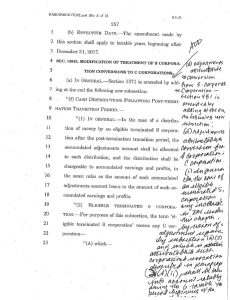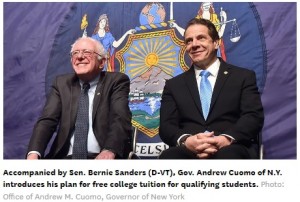Last spring, I wrote about Senator Elizabeth Warren’s college financing proposal for the San Francisco Chronicle. This week, I analyzed for The Conversation former Vice President Joe Biden’s recent proposal to double the maximum Pell Grant as a way of increasing college affordability. The two have taken very different approaches, and assuming they both stay in the race as viable candidates for the Democratic nomination, it will be interesting to see the attention each proposal receives.
Tuition & Student Loans
It’s U.S. News rankings time again
U.S. News & Wo rld Report released its annual compendium of rankings of undergraduate colleges and universities across the nation last week. This is usually an eagerly-awaited event at many institutions around the country, and one with which most of us in leadership positions have a love-hate relationship. On the one hand, we all decry how the process attempts to reduce what are in most cases large, complex, and multi-mission institutions into a single number. On the other, we all recognize the attention it generates and the potential impact it can have on the decisions of millions of college-going students.
rld Report released its annual compendium of rankings of undergraduate colleges and universities across the nation last week. This is usually an eagerly-awaited event at many institutions around the country, and one with which most of us in leadership positions have a love-hate relationship. On the one hand, we all decry how the process attempts to reduce what are in most cases large, complex, and multi-mission institutions into a single number. On the other, we all recognize the attention it generates and the potential impact it can have on the decisions of millions of college-going students.
I’ll cut to the chase and the news everyone is most interested in – USF maintained its top 100 position from the prior year, dropping just one spot from tied for #96 last year to tied for #97. But like the proverbial duck on the surface of the water, this small change masks a lot what is happening below the surface.
Senator Warren’s college financing proposals
The 2020 campaign for president is already heating up, and the Democratic field includes almost two dozen candidates. One of them, Senator Elizabeth Warren of Massachusetts, recently unleashed a widely-covered proposal offering “free college” and elimination of student debt for millions of Americans. In an op-ed in the San Francisco Chronicle, I analyzed why Warren’s proposal is not in the best interests of the nation.
The reasons behind tuition increases
Like many universities, during the spring semester USF announces its tuition and fee rates for the following academic year and sends the announcement to continuing students (as well as the parents of undergraduate students). This year, we received a lot of pushback from students because we had not included information about why tuition was going up next year. A grassroots group of students formed and mounted a protest during our Board of Trustees meeting earlier this month. Our student newspaper, The San Francisco Foghorn, published an op-ed and staff editorial complaining about the lack of transparency. Continue reading “The reasons behind tuition increases”
Public support for higher education is in trouble again (part 1)
This week the Pew Research Center issued a report on the public’s view of higher education in the United States, and the news is not good. The Pew report builds on a similar survey conducted last year, which also found a lack of support for the nation’s colleges and universities.
Continue reading “Public support for higher education is in trouble again (part 1)”
Tax reform that harms graduate students and university employees
The competing House and Senate tax reform bills are large, complex, and often difficult to understand. The Senate bill, for example, is a 479-page document that was passed early in the morning last Saturday and that included last-minute, hand-written passages as shown to the right.  There are numerous parts of each bill that have a large impact on colleges and universities in the country, as well as their students. One estimate calculated after the House bill was passed is that if enacted into law, it would cost students and their families $71 billion over the next ten years. Now that both chambers have passed bills, a conference committee will try to hash out the differences and agree on one bill to be passed by both the House and Senate and sent on to President Trump to be signed into law. Continue reading “Tax reform that harms graduate students and university employees”
There are numerous parts of each bill that have a large impact on colleges and universities in the country, as well as their students. One estimate calculated after the House bill was passed is that if enacted into law, it would cost students and their families $71 billion over the next ten years. Now that both chambers have passed bills, a conference committee will try to hash out the differences and agree on one bill to be passed by both the House and Senate and sent on to President Trump to be signed into law. Continue reading “Tax reform that harms graduate students and university employees”
New York Governor Cuomo’s proposal for free college – still a bad idea
Earlier this week, New York Governor Andrew Cuomo joined other politicians who have proposed free college programs. As I have pointed out about similar proposals made by President Obama and former presidential candidate Hillary Clinton, there are numerous problems with these programs. In a commentary in The Hechinger Report, I outline why this is still bad public policy.
presidential candidate Hillary Clinton, there are numerous problems with these programs. In a commentary in The Hechinger Report, I outline why this is still bad public policy.
Why any discussions of college affordability need to start with Pell Grants
 There has been a good amount of discussion on the presidential campaign trail about the issue of college affordability and student loan debt. I have written in previous blog posts about some of Hillary Clinton’s proposals, as well as those of Martin O’Malley. This week, I wrote a column for the website The Conversation, where I described why any discussion of college affordability needs to start with the role of Pell Grants, the foundation of the federal government’s student aid programs.
There has been a good amount of discussion on the presidential campaign trail about the issue of college affordability and student loan debt. I have written in previous blog posts about some of Hillary Clinton’s proposals, as well as those of Martin O’Malley. This week, I wrote a column for the website The Conversation, where I described why any discussion of college affordability needs to start with the role of Pell Grants, the foundation of the federal government’s student aid programs.
The New York Times misrepresents student debt – again
 As I have written in the past, The New York Times has had a pattern of sensationalizing the status of student loan debt in the country through a series of articles that misrepresent the true status of borrowing. It is a mystery to me why the Times persists in doing so, as they have also published articles that more accurately show the true state of affairs. The most recent misrepresentation appeared last week in an article authored by Kevin Carey, a frequent critic of higher education in this country. Earlier this year I wrote a critique of Carey’s most recent book, The End of College.
As I have written in the past, The New York Times has had a pattern of sensationalizing the status of student loan debt in the country through a series of articles that misrepresent the true status of borrowing. It is a mystery to me why the Times persists in doing so, as they have also published articles that more accurately show the true state of affairs. The most recent misrepresentation appeared last week in an article authored by Kevin Carey, a frequent critic of higher education in this country. Earlier this year I wrote a critique of Carey’s most recent book, The End of College.
In his Times article Carey tells the story of Liz Kelley, a 48-year-old woman who borrowed $26,278 to earn a bachelor’s degree in English in 1994, but whose student loan debt today totals $410,000 – yes, $410,000! As Carey points out, this is a sum of money Ms. Kelley is unlikely to be able to ever pay back given her current career as a teacher at a parochial school. Her total borrowing ballooned because of additional debt she took on for graduate programs (in law, which she didn’t complete, and then education), and the fact that she was infrequently, if at all, actively repaying her loans.
Continue reading “The New York Times misrepresents student debt – again”
Hillary Clinton’s New College Compact

Hillary Clinton, a candidate for the Democratic nomination for president, recently released a set of policy proposals to address the rising cost of college. While there are many good aspects to her plan, there are also some problems with it. In a recent op-ed on the website of The Conversation, I analyzed Secretary Clinton’s plan and some of the barriers to its enactment.